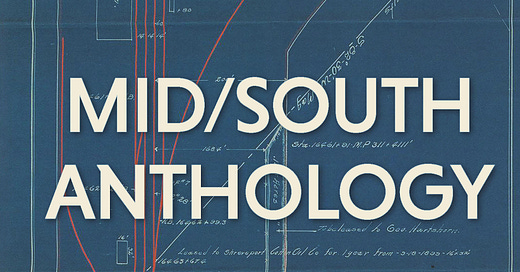Mid/South Contributors: Cassie E. Brown
Learn more about one of the fiction writers in our anthology
I’m grateful that Cassie found us out in the Twitter sphere; her vision as a writer aligns with ours in many ways that reassure me that we are on the right track with this whole publishing thing. Cassie’s short story, “Thawing,” appears in our Mid/South Anthology, but you can also read more of her work in the fourth installment of our Prose Series, just released this month! Read on to learn more about this talented Missouri writer.
Name: Cassie E. Brown
Current Location: Pettis County, Missouri
Bio: Cassie E. Brown is a writer of long- and short-form fiction and essays. Her work draws inspiration from her childhood in rural Missouri, classic children’s literature, and her experiences as a queer misfit. Cassie’s work explores what is ugly, beautiful, and true about rural places and fairy tales. Apart from writing, she is a clinical social worker and a tea aficionado.
Is there anything else you’d like us to know about your work that appears in the anthology?
“Thawing” is a story in which the protagonist has two tender and difficult relationships to cope with: a person and a place. It is the final piece in a quartet of stories set in my world, some fabulist and some realistic, each of which is set in a different season. “Thawing” is obviously the story for spring. Having grown up on a farm, cycles were important to me. I remember calving in the early, greening parts of spring and hunting in hard, cold autumn. Life and death, hope and hunger were predicated on weather. Seasons anchored life. This story had to be told in the spring.
How would you describe your work overall? Do you have other publications you’d like us to highlight?
My work varies in tone and genre. I write literary and speculative fiction as well as essays. A dear friend pointed out that I often center themes of grief, mortality, and write respectfully about people with hard lives. For me that includes rural poverty, queer characters, and outsiders, even in my speculative fiction. I find that my settings often become characters more than set dressing or invocations to mood. I think people underestimate the ways in which place exists in their life as a constant companion, welcome or despised.
I am delighted to have an upcoming short story publication in HELL IS REAL: A Midwest Gothic Anthology, scheduled for release fall 2022 that is a fabulist queer gothic set in Missouri.
How does the Mid-South and/or larger Southern region influence your perspective (personally and/or in your writing)?
The people who raised me were all storytellers. It is in the nature of people here to tell stories. Whether at the smalltown café with my Dad and the farmers and ranchers or around my Grandma’s kitchen table with family and neighbors, stories were everywhere. People shared funny stories alongside curious and tragic ones. I heard them again and again and learned their rhythms. While other cousins were outside causing trouble, I was with the grown-ups, listening. I wanted to capture the confidence and ease of my elders.
A good storyteller develops an ear for the rhythms of speech and the patterns of tales. My very best work is just the inheritance of a long tradition of people who liked to visit over coffee and share a good joke between songs during guitar jam sessions.
Once I began writing, I discovered that the things that spoke to me were influenced by the things I saw every day and the stories I had read as an isolated, bored, intellectual farm girl. I wrote about the fairy tales I read. I wrote about horses. As I grew older, I wrote about the things that set me apart. I wrote about my fear of being outed as queer in a small town. I wrote about struggling with the death of loved ones. Eventually, the pieces came together.
What do you wish more people knew about this area?
It is more than tornadoes and Jesus. It is beautiful and diverse, as much as it is fragmented and hard.
My Missouri county is extremely rural and isolated from the major cities of Kansas City and St. Louis. And about one in every ten people is an immigrant, many from the Ukraine, Russia, and Moldova as well as Mexico and Guatemala. (When I see signs that “stand with Ukraine,” I assume that it is flown by an immigrant or child of an immigrant from the former USSR, probably a Ukrainian themselves.) A little under ten percent of my county is Black. The grandest mural in the county seat is a painting of Black ragtime composer Scott Joplin, who composed the “Maple Leaf Rag” there. The town has a large, thriving nonprofit which provides services for and supports a community for people with all kinds of disabilities across the lifespan. There is rural homelessness. There is an annual LGBTQ Pride picnic. There are sixth-generation ranchers and farmers. There are artists and teachers. Many sorts of people call places like this home.
People who drive by or fly over don’t realize that Missouri is also ecologically important. Currently, native prairie is one of the most ecologically rare and threatened habitats on the planet. What used to be about 15 million acres of prairie now has less than 60,000 acres, less than one half of one percent (Missouri Department of Conservation, 2020). The legacy of colonialism has left one of the world’s most diverse ecosystems fighting for its existence. Extreme weather events like tornadoes and floods endanger lives, as well as crops and livelihoods.
I say all of that to encourage people who don’t live here to complicate their understanding of my home.


